#i spent $60 at a dog store getting souvenirs for my dog
Text




I went to the fish zoo today :3
#the one fun thing i got to do in new orleans#also we did the riverwalk mall thing and that was neat#i spent $60 at a dog store getting souvenirs for my dog#I'll post pics of him in his collared shirt i got him#its precious#selfie#me#chat with me!#mine#chat#bored#talk to me#aquarium#nola#new orleans
11 notes
·
View notes
Text
Traveling to San Francisco on a Budget

Being on a budget sucks. It may be easier for some people, and harder for others, the reason for this depends on each person’s individual financial blueprint. Blueprints (the designs of our context storage boxes) generate since our childhood as our conscious mind develops the subconscious mind stores all the programming. Some of us developed the same financial blueprints from our parents because they are our primary nourishers in our early years.
I grew up with a mother who is a saver and a dad who is a spender. Hello, my name is Diana Cano and I am a spender. Now there’s nothing wrong with either side, most relationships are composed of one saver and one spender and they can bring balance to each other. Budgeting is a key to gaining financial independence and not relying hardly on the sources of income that you have. Yet, it is hard for me to stick to a budget, VERY VERY HARD. I am an accountant and I realize the importance of budgeting for a company without it the company is FUCK*D. A company can be put out of business by the simple fact of not sticking to a budget and not having proper cash/and financial handling (Financial statement-or Good record-keeping system).
If this is true for companies can you imagine what it can do to your personal finances?
My main source of income comes from a W2 job as an employee, which means that I have a fixed income, every paycheck and month I make the same amount. One of my many hobbies is traveling. Traveling is very essential to me because it makes me blissfully happy I have been doing it at least once a year ever since I was 4 years old. Lately, I have been working on incorporating it into my life more often, and thus, what brings us to the topic of BUDGETING.
Why do I choose to be on a budget? Although sometimes is hard for me to stick to a budget when I travel especially when it comes to food, because I do not hold back. It’s either me eating before I get hangry or WW3. The reason why I decided to try budgeting my trips, this being my first attempt is simple; The less money you spend, the longer you can travel for, the more places to visit and spare activities to do.
For this research, I traveled to San Francisco on a budget I am going to break down the entire cost of the trip.
➣$ spent on GAS (round trip) - $175
➣Meals on Restaurants -$162
➣Snack food to cut down meals on restaurant - $30
➣Yosemite National Park Ticket Entrance - $30
➣San Francisco Museum of Modern Art Tricket - $60 ($30 per person)
➣ Pier 39 Parking Ticket - $25
➣Hotel- $350
*Total trip cost: $832
We visited San Francisco for a brief weekend getaway. We left San Diego, CA Friday in the afternoon (after my work) and arrived in San Francisco, CA that night. We showered, rested, and check into our hotel.
The next day, Saturday morning we woke up early to eat breakfast at IHOP and rushed to see the Golden Gate Bridge. The GGB was the whole reason for my visit to SF this historic monument had been on my bucket list for so long. Then we head on to visit one of SF’s museums, she opted for the San Francisco Museum of Modern Art because my partner, Alexis wanted to see the art. It was a great experience, After the museum, we ended the day at Pier 39 we spend money on souvenirs and local shops that I did not include here because it was not relevant to the article since it is optional. We saw the sunset at the Pier 39 and when we got tired after all the shopping and coffee tasting we headed back to the hotel.
On Sunday we went to Yosemite National Park where we hikes one of the easier routes. We took our dog-child, Poe and he was loving every single step of the hike.
Because it was a short trip we had to pick the activities we wanted to explore the most and fit it into two days. It was a short trip definitely not enough to explore the entire city of SF, but we made the most out of those two days, we soaked our feet in a bit of northern California ground and said thanks for this amazing opportunity to travel and be on this earth alive.
This has been by far the cheapest trip I’ve had, and by budgeting, we managed to save a little bit by going underneath my forecast cost for the trip which was around $1,000. I am proud of myself for achieving this because I know how hard it is for me and after this trip, we were able to then planned another weekend getaway to visit the Hoover Dam in Nevada.
Thus, the importance of budgeting when you travel.

**Annex Image 1, the author Diana (me) and her child-dog Poe at Yosemite Park.
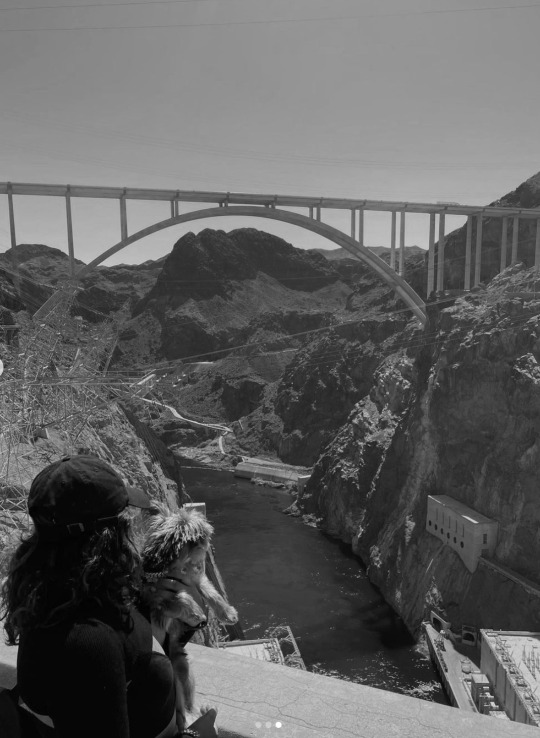
**Annex Image 2, the author Diana (me) and her child-dog Poe at Hoover Dam in Nevada.
#budget#budgeting#nyt#columnist#blogger#travel blog#accountant#black and white aesthetic#analysis#i make book reviews too#book review#explore#blog#aspiring blogger
1 note
·
View note
Text
Paris Vignettes
I found it pretty hard to write about our time in Paris because the city is so present in the American collective imagination. Paris means romance and sophistication. Everyone already knows about the Eiffel Tower, Notre Dame, and the Louvre. What can I say about the place that hasn’t already been said? Not much, which is why I’ve chosen to write more about the little moments than the big monuments. These are the small things that happened on our Paris trip that will likely never be advertised in a travel brochure.
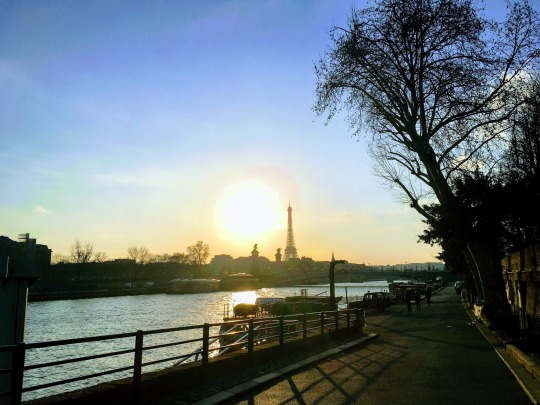
We left home on a sunny Saturday afternoon. As we rode the bus through the town to the train station, I realized it had been ages since I had seen the town in full sunlight like this. I couldn’t stop staring out the window. Even though our town is not what I’d call picturesque, it looked so beautiful with people walking around outside and every factory and apartment building illuminated.
We waited on a bench about an hour at the station for the train to arrive. To pass the time, I eavesdropped on the family seated near us, and learned that they were from the Paris area and were returning home from a ski vacation. The little girl in the family, maybe three or four years old, had left her sunglasses in their driver’s car, and the mom was calling the driver to ask about the sunglasses. After she hung up, she told the little girl that they wouldn’t be able to get her sunglasses back before the train arrived, so they would have to go back home without them. The mom’s work acquaintance, however, was coming to this area in the following week, so she told her that the coworker could probably bring the sunglasses back with her next week. The little girl sounded disappointed. “But I don’t want to go home without my sunglasses…could we call the police and get them to bring my sunglasses?” By the time we boarded the train, I was highly invested in this little girl and the fate of her sunglasses, but since it was all happening in French, Nicolas was unaware of the drama. As soon as we were on the train and out of earshot, I told him the whole story. We laughed. We cried. We hoped that one day she and her sunglasses would be reunited.
We checked into our hostel in Paris after dark. Our room was several flights of stairs above the ground floor, so after we huffed and puffed our way there, we set our things down and checked out the view. There were some trees in a courtyard nearby that partially obscured our view, but the skyline literally glittered with thousands of tiny lights almost too far away to see. I could tell that the Eiffel Tower wasn’t in our line of sight, but I was eager to look again in the morning and see what else was visible in the daytime. It’s certainly easier to navigate in the daylight, but it’s a lot of fun to see a city for the first time in the dark and then discover it all over again the next morning.

We went to both the Louvre and the Musée d’Orsay, Paris’ two most popular art museums. In terms of time period, the Musée d’Orsay picks up where the Louvre leaves off—the Louvre has art from Antiquity until the 19th century, and the Orsay covers about 60 years of art after that, including most people’s favorite Impressionists. So in terms of collections, comparing the two museums is like comparing apples and oranges. However, I really enjoyed comparing our experiences of the two museums and how the space in each building is used.
--
The Louvre is a royal palace that has been repurposed to become a heavily trafficked public building and tourist destination. The oldest part of the building dates from the medieval period, and has been changed and added onto ever since; the iconic glass pyramids in the front are only 30 years old. In terms of the floor plan, it’s pretty typical for a European palace. There are two main wings where you basically travel down a straight line of progressively smaller rooms. As an art museum—and as the world’s most popular art museum—it’s kind of a nightmare. We couldn’t find a single staircase that let us access all five floors. Several times we wanted to leave the right wing and go to the left one, or vice versa. And after studying the map, making a game plan, carrying out the plan, and checking the map again, we realized with frustration and horror that we had never left the first wing at all. After an exhausting day of wandering around through crowds of people, we were lucky to finally find the exit. Don’t get me wrong, it was really cool to see the Mona Lisa and tons of other masterpieces. It was just interesting to see how the choice of layout for the museum had very real physical and emotional implications for us and our trip.
--
The Orsay, mercifully, is not an old palace—it’s an old train station. The main entrance area is therefore a giant open room with a rounded glass ceiling and a huge clock. Most of the paintings are held in rooms branching off from this central area, so it’s very easy to orient oneself and to travel to the rooms you want to see most. And this is what one would expect from a train station, where it is important for large crowds of people to be able to get from A to B without much trouble. Our day spent in the Musée d’Orsay was overall much more pleasant and comfortable than our day in the Louvre, not because we liked the art so much better (even though we did) but because the building was better suited to tourists and art.
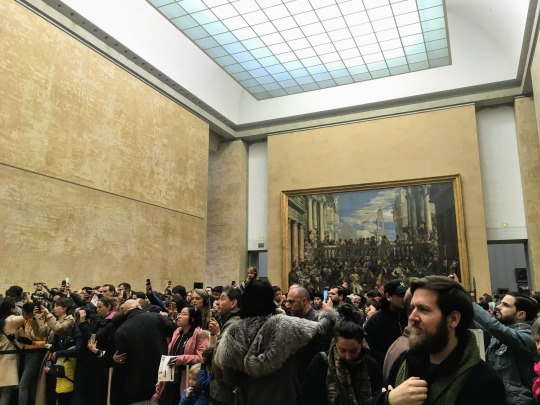
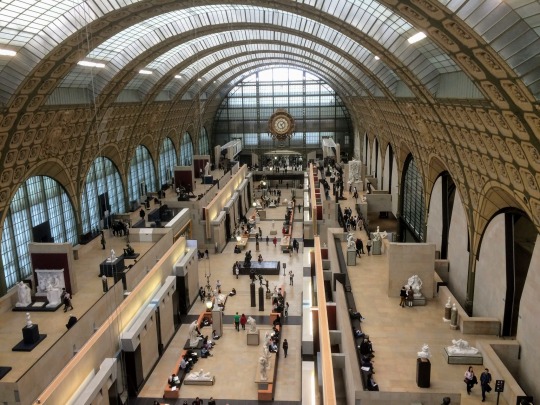
On one cloudy morning, the first item on the itinerary was walking around the neighborhoods on the banks and islands of the Seine. We wandered down whatever streets looked most interesting. We went to the small park on the point of one of the islands and snapped a few pictures. Later that day in the Musée d’Orsay, we saw a Pissarro painting of the almost exact same view we saw from the point of the island.


We were supposed to only spend a morning in the Musée d’Orsay, but we enjoyed it so much that we ignored our grumbling stomachs and stayed until 4pm. As I think I’ve mentioned before, the French are pretty particular about mealtimes, and lots of restaurants close between 3pm and 7pm. Paris has enough demand from tourists at odd hours that we could have easily found a restaurant open between those hours, but we were just too embarrassed to violate the culture so flagrantly. Instead, we went to a grocery store and bought some pre-made sandwiches, a box of crackers, and two yogurts. We brought our food to the Tuileries garden and ate in a secluded corner, enjoying the unusually pleasant weather, pointing out cute dogs to each other, and daydreaming about what our lives might be like if we lived in Paris.
Europe has a lot of religious art, and we both paid attention in Bible study, so we’ve gotten pretty good at identifying our saints and Bible stories in the paintings and sculptures we see. For example, in a painting of the disciples, Peter is always going to be the one who is balding in a horseshoe pattern, with one tuft of gray hair in the middle of his forehead. John is always going to be the youthful-looking one with no beard and longish auburn hair. In Paris, we decided to make a game of looking at an artwork and guessing the Bible/Church history scene before we looked at the title. It was our own little trivia competition each time we toured an art museum or cathedral. My personal favorite story to spot is Saint Anthony of Padua preaching to the fish, and one of my favorite artworks is this stained-glass representation of the book of Revelation.

One afternoon we headed to the outskirts of the city in order to go to the Musée Marmottan Monet. On our walk to the museum, we passed a horse trailer parked on the side of the road. My Kentucky brain didn’t register that that this was an odd thing to see in Paris, but Nicolas excitedly said, “Chevaux!” when he recognized the word written across the trailer. We rounded a corner, and then we found the chevaux: they were hitched to old-timey carriages parked in the middle of the street, surrounded by people in 19th century period costume. We were told by the man working security at the corner of the street that a TV series was filming there that day. We had to wait for permission to hurry into the museum between takes.
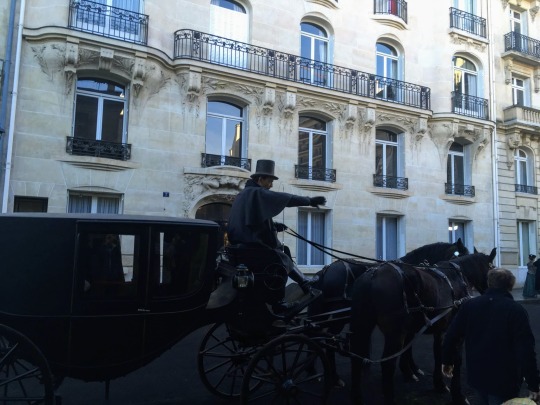
We went to the Eiffel Tower around sunset so that we could see in the daylight and lit up at night. We took a few pictures, then just spent some time looking at it quietly and trying to absorb the moment. A street musician from the US was performing nearby—we were there long enough to hear, of all things, “Santeria” by Sublime and “Wagon Wheel” by Old Crow Medicine Show. Those were probably the last two songs I’d want to hear while trying to appreciate the Eiffel Tower, but in spite of this, and in spite of the selfie sticks and souvenir hawkers, it really was as cool—moving, inspiring, romantic—as people make it out to be.
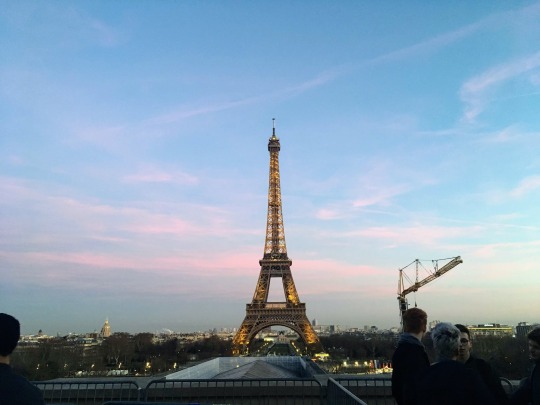
1 note
·
View note
Text
How to Road Trip Around Oahu
Posted: 8/3/20 | August 3rd, 2020
I didn’t know much about Oahu before I visited. Everyone told me it was worth it for Pearl Harbor but to spend the rest of my time elsewhere in Hawaii. Maui and Kauai were where the action was, they said.
But Oahu was home to Honolulu’s international airport from which I was catching an onward flight to Taiwan. Since I had limited time, going to multiple islands wasn’t feasible.
Fortunately, after spending a full week on Oahu, I can say this: everyone was wrong.
Maybe they just let their preconceived notions get the better of them.
Or maybe they just didn’t give the place a chance.
But, whatever the reason, I’m here to tell you that Oahu has some magic to it. Sure, it’s quite developed, has terrible traffic, and huge crowds. And yeah, maybe it’s not as “raw” as the other islands (I assume that’s why people like them).
But there are plenty of spots in Oahu where you can live that Hawaiian dream
I spent a week round-tripping the island (which, given how small it is, turned out to be quite easy). My plan was simple: sit on a beach as long as I could, eat my body weight in poke (diced raw fish, pronounced “po-keh”), and hike.
Along the way, I also binged on shrimp, drank the best piña colada of my life, and took notes so you can do even better when you visit!
Driving Oahu: A Road-Trip Itinerary
First, a tip: if you’re driving around Oahu, go counterclockwise from Honolulu, since most of the food trucks you’ll want to stop at are on the ocean side of the highway as you go up the east coast. So going in that direction just makes it easier to pull off the road and try all the food trucks that line the highway (and there are a lot). There’s also more to do on the east side of Oahu, so it’s best to start there.
That said, I actually don’t think a traditional road trip is the best idea. Oahu is smaller than you think — you can drive end to end in under two hours — so everything listed below can really be done as a day trip from one base or another, which will save you packing and unpacking, as well moving from place to place too often (especially since the east and west coasts don’t have a lot of affordable accommodations).
Base yourself on the North Shore for a couple of days and then in Honolulu (in the south) for a couple of days (or vice versa).
Day 1: Honolulu to Kailua (28 miles)
Pick up your rental car, head out of Honolulu (you’ll be back later), and start off at Hunauma Bay in southeast Oahu. You can spend a few hours there snorkeling and relaxing on the beach before heading to the nearby Halona Blowhole Lookout for the view and Makapu‘u Point (Oahu’s easternmost point) for a short hike. There are also plenty of beaches, food trucks, short hikes, and viewpoints along the way to Kailua, where you’ll want to stay the night.
Where to Eat:
Teddy’s Bigger Burgers
Any of the food trucks on the way north
Buzz’s Steakhouse (for dinner)
Where to Stay:
Airbnb is the best option, since there aren’t many hotels or hostels in Kailua. Book early though, as there isn’t a lot to choose from.
Day 2: Kailua to Haleiwa (50 miles)
Start your morning with the famous Lanikai Pillbox hike just south of Kailua, where you can get sweeping views of the ocean and the cities and beaches on this side of the island. The hike is short (it only takes about 20-30 minutes) but steep, so wear appropriate shoes.
If you have some time in the morning, Kailua and Lanikai beaches are both beautiful (they’re right next to each other and on the way from the pillbox hike). Not a lot of people, white sand, blue water. They’re heaven.
As you leave this area to head north, visit the Ho‘oamaluhia Botanical Garden (it’s free!), which is also home to a lake filled with tropical plants.
Afterward, drive up the east coast toward the North Shore. Along the way, you can stop at the Kualoa Ranch, where many movies have been filmed. If you do a tour, I suggest the 90-minute Hollywood Movie Sites Tour (which includes scenes from Jurassic Park!), as you don’t need much more time than that to see the ranch. (It’s expensive, though, so if you’re on a budget, I’d skip it.)
As you keep going north, you’ll find a ton of beaches and hikes (there are plenty of signs for everything). I really enjoyed the Hau’ula Loop Trail especially, which is about 10 miles north of Kualoa. It’s a really overgrown trail, so you’ll feel like you’re very much in the jungle (meaning you’ll also need to bring bug spray). And like most hikes here, there’s a scenic viewpoint!
Then drive around the northern tip of Oahu to Haleiwa, your base of operations while on the North Shore.
Where to Eat Along the Way:
Kalapawai Café and Deli
Fresh Catch Kaneohe
Shrimp Shack
Seven Brothers
Ken’s Fresh Fish
Fumi’s Shrimp
Where to Stay:
Airbnb is again the best option, as there aren’t many hotels or hostels in Hal‘eiwa. Book early here too.
Days 3 & 4: North Shore (Base: Haleiwa)
This was my favorite part of Oahu. It was Hawaii the way you imagine it should be: a lot quieter, less touristy, and less developed. And it had that whole “hippie vibe” going for it. Everyone up here was much more laid back than down south.
You can learn to surf here (two-hour lessons begin at just $80 USD) or hike the Ka‘ena Point Trail (west of Haleiwa) and/or the ’Ehukai Pillbox (east of Haleiwa). The latter is pretty muddy, so bring appropriate shoes.
Haleiwa itself is a sleepy little tourist town with a bunch of restaurants, shops, and parks. There’s not much to do in the town itself than eat and window shop.
If you do just one hike, though, I definitely recommend the Ka‘ena Point Trail, which was one of the best experiences I had. It’s a scenic two-hour coastal walk to the northwestern tip of Oahu, where you will find a protected biological area with seals and native birds. At the tip, you can see all the way down the west side of the island — a magical view. Bring sunscreen and water, as the whole trail is exposed to the sun.
Where to Eat:
Ted’s Bakery
Sunrise Shack
Hale‘iwa Joe’s
Matsumoto Shave Ice
Ray’s Kiawe
Kono’s
Jenny’s Shrimp Truck
Giovanni’s Shrimp
Day 5: Dole Plantation, Oahu’s West Side, Honolulu (60 miles)
Head south (inland) and stop at the Dole Plantation. While it is super cheesy and touristy (I mean, so many useless souvenirs!), it does have a cool maze, and there’s a train ride through the farm that, while whitewashing a lot of bad things, was an interesting look at the importance of the pineapple to Oahu. For a general overview geared to your average tourist, it was surprisingly informative.
Afterward, continue south toward Honolulu and then head west on the H1 road to the west coast for some deserted local beaches, such as Ma’ili, Ewa, Makua, or Yokohama. Stop at Countryside Café for some incredible diner food. The portions are pretty large, so you can share them.
Then head back into Honolulu, as there’s not a lot of accommodation along the west coast. If you do want to stay longer, you’ll find some listings on Airbnb and Booking.com if you book far in advance. Otherwise, there are a few hotels in Kapolei if you don’t want to drive all the way to Honolulu.
Days 6 & 7: Honolulu
I actually liked Honolulu a lot (the main beach area of Waikiki is a tourist trap though.) While downtown is a bit bland, other neighborhoods are filled with awesome stores, breweries, bars, restaurants, and art galleries. Be sure to check out the “hip” Kaka‘ako part of town in particular.
Consider going on a hike on Diamond Head, a volcanic cone on the east side of town. It offers an incredible view of the city, though it’s one of the more popular trails in the area so if you aren’t there early enough to beat the crowds you’ll basically be walking in a slow-moving line up the mountain. If you are short on time, skip it.
Other Things to Do:
A free walking tour with Hawaii Free Tours (call ahead, since they only run when they have bookings).
Pearl Harbor – This is a must. It’s not even up for debate. You have to go.
Iolani Palace, the former royal residence of Hawaii’s monarchs.
Soak in the sun on Waikiki Beach or other nearby beaches, such as Ala Moana, which is popular with locals.
There’s also an Islamic art museum, which is supposed to be great, but I didn’t make it there.
Where to Eat:
The Pig and the Lady
Mei Sum Dim Sum
Shirokiya Japan Village Walk
Rainbow Drive-In
Leonard’s Bakey
Ono Seafood
Hula Dog
Where to Stay:
The Beach – This hostel is right on the beach, includes free breakfast, and has plenty of space to relax and meet other travelers.
Polynesian Hostel Beach Club Waikiki – The accommodation here is basic, but the staff are super friendly and helpful, and they organize lots of events.
Waikiki Beachside Hostel – A fun, social hostel that hosts live music. Breakfast is included too.
Additionally, head to the Royal Hawaiian Hotel for the best piña colada of your life. It’s not cheap ($15 USD a pop), but it is sooo good! Every one of my friends who didn’t order one got it as their second drink. (Fun fact: My grandfather was stationed in Oahu during WWII and went back to Oahu often. The Royal Hawaiian was his favorite hotel. It’s pretty cool that it’s still there!)
Average costs
How much do things cost on Oahu? Here are some typical prices (in USD):
Airbnb – $100+/night for a one-bedroom or studio
Hotel – $175–250/night for a mid-range boutique hotel
Hostel dorm – $27
Car rental – as low as $20/day, plus insurance
Gas – $3–3.50/gallon
Poke bowl – $12–15
Takeout meal – $10–14
Sit-down meal at a fancy restaurant (with drinks) – $50+
Local lunch – $15
McDonalds – $6 for a value meal
Groceries – $75 for one person for a week
Beer (at a restaurant) – $8–10 ($2–3 at the Japanese Walk!)
Piña colada – $10-15
Coffee – $5
Surfboard rental – $25/day
Snorkel gear rental – $15/day
Scuba dive prices – $125
Budget Tips
Oahu is pretty expensive. Most everything has to be imported, so if it can’t be grown nearby or caught in the ocean, expect to pay a lot. But it’s not impossible to save money. Here are a few ways to cut your expenses:
Hike and enjoy the beaches. Nature is free!
Buy your own food from supermarkets so you can cook your own meals or have picnics. Sure, there are plenty of world-class restaurants here, but if you want to keep your food costs down, you should cook some meals. The poke at supermarkets is delicious anyway!
If you do eat out, hit the food trucks. Most cost around $10 USD for a meal — much cheaper than sit-down restaurants.
If you’re going to buy alcohol, do so at Japanese markets, where you can find beer for only $2–3 USD (compared to $8 USD at bars).
Skip ride-sharing websites like Getaround or Turo (where you rent cars from private owners). They are usually cheaper than the big rental companies, but on Oahu, hosts charge you an added fee for dropping the car at the airport. I found the traditional car rental companies to be much cheaper, with rates as low as $20 USD a day.
Get your gas at Hele stations. They were consistently the cheapest on the island.
***
While Oahu is often crowded and overly commercial, there were a lot of wonderful things to do and see. To me, the best parts were the food and the hiking — with so many hikes, you could spend weeks here. My favorite part of Oahu was the North Shore, so I recommend you spend a few days there at least. I certainly look forward to returning!
Book Your Trip to Hawaii: Logistical Tips and Tricks
Book Your Flight
Find a cheap flight by using Skyscanner or Momondo. They are my two favorite search engines because they search websites and airlines around the globe so you always know no stone is left unturned.
Book Your Accommodation
You can book your hostel with Hostelworld. If you want to stay somewhere other than a hostel, use Booking.com as they consistently return the cheapest rates for guesthouses and cheap hotels. My favorite places to stay in Oahu are:
The Beach
Polynesian Hostel Beach Club Waikiki
Waikiki Beachside Hostel
Don’t Forget Travel Insurance
Travel insurance will protect you against illness, injury, theft, and cancellations. It’s comprehensive protection in case anything goes wrong. I never go on a trip without it as I’ve had to use it many times in the past. I’ve been using World Nomads for ten years. My favorite companies that offer the best service and value are:
World Nomads (for everyone below 70)
Insure My Trip (for those over 70)
Medjet (for additional repatriation coverage)
Looking for the best companies to save money with?
Check out my resource page for the best companies to use when you travel! I list all the ones I use to save money when I travel – and I think will help you too!
Need an affordable RV for your road trip?
RVshare lets you rent RVs from private individuals all around the country, saving you tons of money in the process. It’s like Airbnb for RVs.
Want more information on Hawaii?
Be sure to visit our robust destination guide on Hawaii for even more planning tips!
The post How to Road Trip Around Oahu appeared first on Nomadic Matt's Travel Site.
from Nomadic Matt's Travel Site https://ift.tt/2Xour7v
via IFTTT
0 notes
Text
After our beautiful 24 hours on Islay, the Spring Break 2018 trip to Scotland continued from Glasgow as we headed north to Ballachulish. Exiting the airport in the rented Land Rover was… challenging. We weren’t on Islay anymore. There were other cars to tailgate, pass, ward off and not hit. Yet, no cows or sheep which was a big plus. I think.
The screams of “STAY TO THE LEFT!” from my co-pilots (Mrs. Satellite Engineer, Teenager Daughter #1 and Teenager Daughter #2) were taken a bit more seriously this go around. The rumor is true. Everyone really does drive on the other side of the road in Scotland. I thought maybe it was a cute little Islay thing from days long ago when horse and buggies ruled the world. I was actually hoping that was the case. And speaking of go around… ROUNDABOUTS!
The nice British lady stuffed into the dashboard alerted me with “At the next roundabout, take the second exit” which was very kind and almost didn’t scare me. She sounded very nice, yet a tad authoritative for my liking. We’d battle for days as she nagged and nagged.
The drive was gorgeous with a variety of greenery abounding from the road up into the hills as we trekked the A82 through the western side of the Loch Lomond and The Trossachs National Park. Snow covered mountains were upon us before we knew it. Snow?! This was going to be a great drive as long as I STAYED TO THE LEFT. And it didn’t snow.
Ballachulish
The goal on this day was reaching Ballachulish. We were staying in the Craiglinnhe House, a bed and breakfast, on Loch Linnhe’s southern side. Built in 1885, this Victorian home is across the road from the loch and was a splendid and comfy place to rest our weary heads for a few nights as we explored the Glencoe and Fort William areas. Owner Lawrence Hughes is the nicest of hosts offering help of all sorts, tourist tips, and tasty full breakfasts with warm and and pleasant attention. The bedrooms were quaint and warm. The sitting room was cozy and, much to my delight, stocked with a table of spirits, wines and mixers to pour oneself to relax with. And after a day of driving, I warranted, daresay deserved, some relaxing.
Our stay in the area led us to a gondola ride up Ben Nevis (recommended by Lawrence) where there was still a fair amount of snow. The Beast of the East had played havoc with Scotland in much of January and February so it’s not certain if the white stuff we tromped around in was remnants of that bizarre storm pattern or just normal for the country’s tallest hill. At over 4,000’ it’s tough to call Ben Nevis a mountain where it would barely make the top 50 highest in California. But it was majestic overlooking the Highlands valley below, and shocked us as a ski and snowboarding destination.
We also had a couple nifty views of The Castle of Aaaaarrrrrrggghhh, i.e. Castle Stalker situated in an inlet of Loch Linnhe. It looked rather menacing at 600 years old. But who wouldn’t? A long guided hike in Glencoe’s Highland Reserve got us out into nature. And in the little village of Banavie we took a pleasant walk up Neptune’s Staircase, the longest staircase canal lock in Britain, showing us a fascinating industrial side of the area as well as (and more importantly) many dogs!
After our second day’s breakfast at the Craiglinnhe House and our goodbyes to Lawrence, we headed again up the A82 north towards Inverness. A stop at Urquhart Castle was a chilly and breezy one along Loch Ness. A busy place with tour buses and visitors from all over with Germans leading the numbers, Urqhart was interesting as our first “touristy” stop (we happily avoided any of the Nessie stops). The ruins are intact enough to see how the Scots and English lived at the fortress. My guess is that it was no 13th century version of the Craiglinnhe House.
Mrs. Satellite Engineer and I get a kick of ruins and she had more interesting ones in mind. The daughters would have to deal with it. Corrimony Chambered Cairn is west of Loch Ness outside of Drumnadrochit which is just fun to type. Corrimony is a burial cairn site, oh, about 4,000 years old for those of you scoring at home. A domed construction made of rocks and out in the middle of nowhere, it’s a place I’d like to be buried if you can keep the sheep out and guarantee that some joker won’t take the rocks as souvenirs. Bastards. All three women in our party climbed into the small passageway towards the middle never to be seen again…uh, I mean, and were heard laughing and shrieking scaring the nearby sheep as I walked back to the car pretending not to know them while apologizing to the sheep on the way.
A bit more driving via Inverness and we were in Speyside. Brown Malt Whisky Trail roadside signs popped up and I knew we were in a good place to be on our planet.
Rothes
On the recommendation of a friend who we will meet in a bit, we made our way to the small town of Rothes. It could well classify as a village but I’m not sure what the Scottish definition is. Night skies were upon us as we parked at the Station Hotel on the side street adjacent to the hotel. There was a small parking lot right across the street that was interesting since it had a large copper still in it looking like a monument of sorts. Hmmm. As we unloaded the car to check in, it was hard not to miss the factory behind the hotel not a few steps from where we parked. Forsyths was the name on the sign. Yeah, that one. The one that makes the majority of the copper distillation vessels for the whisky industry. Huh. Right behind our hotel. Go figure.
At the registration lobby and our brief look into the hotel, copper seemed to be a “theme”. And a Forsyths company brochure laying on a table brought more head scratching. The Station Hotel was beautiful and our two room family suite was roomy and quite elegant. After a quick unpacking we headed back to the hotel pub, Toots Cafe, for some dinner. A lively group filled the tables. Football on the big screen. It was like any bar at home almost. The menu was full of many choices but the whisky list was…heavy on the “many”. Oxford Dictionary heavy but with bigger font. This was going to take awhile to peruse. Order some food, family! I’m reading!
The hotel’s whisky bar, The Spirit Safe, a few turns aways from Toot’s has 500 or so whiskies and…a spirit safe made next door at Forsyths. A unique drinking space, the front of the bar is adorned with a copper silhouette of a still for each Speyside distillery. Speyside has 60 distilleries. That’s a lot of silhouettes. As we learned that night, the Forsyth family owns the Station Hotel. An old hotel in need of repair, Richard Forsyth and his wife took it upon themselves a few years ago to restore it back to its former grandeur. And they have. The food, drink and accommodations were superb. Five star in my book. This was not a sleepy roadside motel. There was a quiet elegance to it and a highly recommended stop by us.
Glen Moray Distillery
The next morning after a delicious breakfast of oatmeal, salmon, eggs, toast and tea in the hotel, we headed back to Elgin about 20 minutes away. First stop: the Glen Moray Distillery. On my last trip to Scotland with the Single Cask Nation boys, they took us to Glen Moray for a fun visit that included a tour led by Master distiller and distillery manager Graeme Coull, a blind tasting to choose a cask for The Jewish Whisky Company, and then an entertaining dinner out with our group, Graeme and his wife, Faye, and their visitor center manager, Iain Allan. I’ve kept in touch with the Coulls and after various exchanges, a visit again was in order.
The drive to Glen Moray is a bit of an eye opener and a wee bit confusing. Did this woman in the dashboard know where she was going? Why are we in a neighborhood? With houses. And trees. And frontyards. And rubbish and recycling containers. We all know neighborhood bars but Glen Moray is a neighborhood distillery. Faye and Graeme actually live on the premises in a house next to the distillery shop.
The lovely Faye met us in the shop and it was like seeing an old friend. She welcomed the family with open arms asking all kinds of questions about our trip to date. She was a trove of information too. And truth be told, she recommended the Station Hotel (thank you, Faye!). She also gave us great ideas for lunch that day and dinner later on (keep reading).
Iain then Graeme made their way into the visitor center and it was just great to visit again with them. The boys as affable as I recall. The shop is half whisky-centric and half cafe. But I found the cafe area almost more interesting. As we stood and chatted, the cafe slowly filled up. It was 10:00 am. A stream of locals were making their way in for their morning tea, scone, or whatever was on the menu. Yes, there was potato leek soup (The National Soup of Scotland). We weren’t on a desolate piece of farmland or in an industrial strip of warehouses. The Glen Moray Visitor Center is a hangout for the neighborhood which made it feel hyperlocal and even more welcoming.
The distillery has been undergoing a wealth of construction and upgrades to increase capacity. And much like here, the wheels of progress grind to a halt waiting for permits from the local government offices. Graeme had his hands full this morning so he put us in the vary capable hands of Ionna to lead us on a private tour of the distillery. This “special” treatment didn’t go unnoticed by the girls who like their mother was agog at the industrial science on display. After a tour of the “hardware”, Ionna led us to a warehouse that was undergoing a roof replacement – bit breezy and chilly in there with the blue skies above. She popped opened a few casks so we could put our noses in. Mmmm.
Back inside the visitors center, it was tasting time (and shopping). Since I had driving to do, Ionna and Faye kindly packed me some to-go samples for later while Mrs. Satellite Engineer sampled at the counter. We spent a “few” pounds in the store of course on whisky and stuff because we’re very good at spending money in foreign countries on stuff. We’re pro-globalism and the economic “benefits” of it. We did our best to prop up the Elgin economy. A bottle of the Glen Moray cream whisky liqueur that I’ve been jonesing for since my last visit, a 100% Chardonnay cask expression; a 22 year old that spent the last six years in an Islay cask from an “L” distillery (you guess which one); and a 13 year old bourbon cask pour-your-own which I poured and the teenagers labeled and sealed under Iain’s guidance. I sense internships in their future.
As I expected, the good folks at Glen Moray were simply kind, wonderful hosts and great ambassadors for Speyside. The neigborhood is lucky to have them and we’re lucky to have Graeme, Faye, and Iain as friends.
Elgin Adjacent
Next stop on the Old Ruins Tour (without Ozzy) was Duffus Castle between Elgin and Lossiemouth. Built around 1150, this ancient motte and bailey style castle is but ruins now, and one of those landmarks that seemingly doesn’t get many visitors if the size of the car park is any gauge. Atop a big grassy hill in the middle of somewhere with the North Sea in the distance, the ruins are desolate, breezy, and peaceful. There were a few informative signs of what this wall or that wall were long ago, just enough to fill one’s quest for some answers. It’s a vast property that takes some imagining to wonder about how the castle looked and functioned centuries ago. On this day it functioned admirably as a dog park as we met a couple walking their two retrievers, Sam and Frodo. The two hobbit dogs were much like their owners; as friendly as can be.
The quiet of the visit was interrupted every five or ten minutes by a very loud blur in the sky. The Royal Air Force’s Lossiemouth airbase lies between the castle ruins and the North Sea. Lossiemouth is home to the RAF’s Typhoon fighter squadrons responsible for intercepting Russian aircraft per Sam and Frodo’s master. I wasn’t doubting him since breakfast was whisky and eggs, not borscht and vodka. The jets took off and landed in easy sight distance. Scorching across the skies with regularity, the nearby sheep barely cared obviously feeling very protected from enemy foreign rustlers. We drove by the airbase that was built in the late 1930’s and could see the castle not far back in the rearview mirror. Bet those kings would have liked to have these flying machines at their disposal.
Lossiemouth
Off to the quaint coastal town, again a suggestion from Faye at Glen Moray, we found ourselves mesmerized by the homes overlooking the rough North Seas. We could have driven up and down every little street all day. Moray Golf Club hugged the sea and duffers battled the winds on this links course. This was golf in the traditional Scottish way, no doubt, and for a bit, was played under no sunshine either. We made it to “downtown” Lossiemouth and walked the small streets by the ocean and harbor as waves crashed over the break walls. It was lunchtime so we headed into Harbour Lights Bistro & Cafe (highly recommended by Faye). We brought the average age down a bit as this place catered to the senior set. Canes and walkers (which is the name of my future distillery) were the transportation aid of choice. But the well dressed crowd were pleasant only staring at the Southern California contingent occasionally.
Lunch was delicious and highlighted by soup! No, not potato leek. Don’t you wish. A hearty bowl of Cullen skink was intoxicating with all the its aromas. Thick and chunky, creamy and a bit salty, this was a soup that pulled you into its depths and to the folks sitting around you. The haddock was fresh and was locally sourced from the sea. Duh. The vegetables were firm and from the earth nearby. This tasted like Scotland and the people seated around us. This was a working class albeit retired crowd who no doubt worked hard through their lives weathering good and bad days, and harsh winters by the sea. This was a soup that spoke of the sea and their Speyside people. And a few crusty rolls and a dram of BenRiach made it all the better.
Before leaving Lossiemouth, we stopped a few blocks away from where the buildings ended. The bluff there was covered in long grass and edged towards the rough North Sea. We were a long 9-iron from the rocky beach below. The short tromp across the bluff put us pitching wedge distance in rough that would be challenging enough for Rory, Justin, or Tiger. The battering waves were mesmerizing even as birds ducked in and around the puffs of wind flitting above the shore. To the west the Typhoons jetted towards the cloudy horizon barely visible from this spot. The sea air was chilly and damp, the wind was no friend here. Turning to look at back at the buildings of Lossiemouth behind, it was hard not to envy the locals and their particular spot on the map.
Downtown Elgin
Next stop was Elgin Cathedral. This 13th century series of remaining structures is impressive in scope, size, and sheer age. A self-guided tour takes one up the cathedral towers and the many levels they have. Each landing has a well organized display of artifacts and historical data. The climb up the narrow spiraling staircases is a bit dizzying but well worth the spin. And the view of Elgin, River Lossie, and Cooper Park, from the roof is spectacular as well as the bird’s eye view of the Cathedral’s expanse. Each parent explored with one daughter. I got the 15 year old who was more than happy to lead me up and down the staircases, through the chapel ruins, and amongst the centuries old cemetery plots. Again, there were a scattering of folks walking the ground leaving us relative quiet aside from the riding lawnmower chugging along the property tidying up the grass.
Before heading to dinner, we stopped in “downtown” Elgin proper. The Gordon & Macphail Shop was on the list to see. The front part is more of a foodie shop with deli options, various jams, honeys, cheeses, and the like. The back of the store is the whisky room with full walls of G & M offerings of all ages. There were almost as many non G&Ms but by and large nothing noteworthy. There was a top shelf with unreachable bottles in the thousands of pounds. Port Ellens, Broras, Macallans, et al. The gentleman behind the desk was nice enough and let me peruse the list off offerings. The sheer size of the list was more impressive than the actual shelves. I’m not sure what I was hoping for but I felt a bit disappointed. I did add to my mini bottle inventory with a few purchased there though.
Craigellachie
The twenty minute drive south on the A941 took us through Rothes and onto Craigellachie. A tiny burg on an elbow of the Spey, Craigellachie was our stop for dinner. Fay Coull (thanks again, my dear!) suggested that night’s choice and called ahead to get us reservations at the Copper Dog located on the ground level of the Craigellachie Hotel. The hotel’s exterior has an old world charm but the Copper Dog has a new world ambiance. Small part pub, large part restaurant, it was quite the fun experience. Regulars populated the pub, football on the telly, pints poured. We sat in a quaint dining room that was adorned with plenty of wood and repurposed furniture. It was casual, not trying too hard to be cool or hip. Our redheaded server seemed more of manager than server and took great care of us, laughing with us at just about everything we talked about. My Glencairn never went empty for long with the long list of choices. The dinner choices were not simple pub fare. This was a sophisticated menu that was difficult to choose from. Meats, fish, veggies, all locally sourced (within a 40 mile radius) and prepared without fault tempted us in so many directions. A delicious evening and highly recommended. After dessert (of course), we walked up Victoria Street past the noted Highlander Inn. The chilly air felt good as did the short jaunt with our full bellies.
Back to the Station Hotel, the missus and I headed to the The Spirit Safe for nightcaps. A long day filled with food, whisky, history and the best of Speyside’s beauty.
Before breakfast in the hotel the next morning, Teen #1 and I took a walkabout Rothes. We started south along the main street passing ancient building and store fronts, the Church of Scotland, the pharmacy and the road to the Glen Spey Distillery, with Glenrothes a bit farther west. Heading back through the neighborhood to the east, we met various locals, humane and canine, all pleasant and friendly. River Spey separated Rothes Primary School from Mackessack Park, a large triangular public green space and home to the Rothes Football Club. We made our way along the river spotting several pooches on their morning jaunts before turning back towards the A941 from the north. We passed a driveway into the Forsyths plant and saw many stills at some point in production possibly awaiting to be loaded up and delivered or shipped. The stills were a tad blinding with the sun beaming off their reddish skin. Teen #2 found a new friend in a little black cat from a house next to the factory. Back to the main drag and were we back at The Station.
It was time to pack the car and head south. Speyside struck a chord in our hearts. Its villages and people had grown on us over the last two days. It’s a special place with an ancient heart from sea to valley, from hills to Spey.
Part II of @AaronMKrouse + his Clan's #SpringBreak travels in #Scotland takes us to #Speyside. @VisitScotland @TheMWT After our beautiful 24 hours on Islay, the Spring Break 2018 trip to Scotland continued from Glasgow as we headed north to Ballachulish.
#Drinkwire#Family Vacation#Photography#Scotland#Speyside#Spring Break 2018#The Malt Whisky Trail#Travel#Whiskey#Whisky
0 notes
Text
Tokyo, Japan
I am not sure why, but I had always been drawn to Japan. I originally went on a group tour around part of the country. Initially, I had the philosophy of only going somewhere once, unless I had already finished seeing all that I needed from the world. So far, this is the only place that I made that exception.

My first tour here ended in Tokyo, but I had only spent half a day here and had to leave first thing in the morning back home. Our hotel (Prince Park Tower Hotel or Tokyo Prince Hotel…I couldn’t remember the exact name) was near Tokyo Tower. We were not able to see as much as we wanted in that short period of time.
We booked this trip for a few reasons: It was my husband’s and my fifth anniversary together, and it was a collective birthday present for us (as we both have birthdays in April). Plus, my brother had always wanted to go during cherry blossom season.
Saturday, April 7, 2018 – Arrival
We arrived at Narita Airport on a VERY windy day (as in “first-time-getting-motion-sick-on-a-plane-type-of-windy.”) Clearing immigration and getting our bags didn’t take a lot of time. However, we were planning to get our Tokyo Rail passes at the visitors’ center, and by the time we finished with customs, the desk was closed (missed by 5 minutes, at 8:50pm). It was evening, we were tired, and I didn’t feel like figuring out the rail ticket machine. Besides, the last time I was here, the ride from the hotel to Narita wasn’t that much.
Boy was I wrong!
The charge for the taxi ride from Narita to Ginza, Tokyo, was upwards of $250!!!
Later, I was reminded that we had a shuttle from the hotel that we were at to Narita (oops).
Moral of the story here: Learn from my mistakes and do your research on transportation options before arrival.
Now that we have taken care of our PSA moment, on to the rest of the story!
We arrive at our hotel, Mitsui Garden Hotel Shiodome Italia-gai (2-14-24, Higashi-shimbashi, Minato-ku, Tokyo, 105-0021). It is minutes away from Ginza, Tokyo Tower, Zojo-ji Shrine and the Imperial Gardens. They also provided a free loaner smartphone that guests could use to make and receive calls, as well as for email, GPS and social media services. I mostly used it for GPS to navigate through the city.
We were also next door to a Lawson Station, one of the popular convenience stores – along with 7-Eleven – in the country. What was different about these convenience stores is that they carried more variety of foods, including hot food. It has been the locals’ favorite for fresh, convenient food. They are open 24 hours a day, which helps if a worker has an early 4am start or if they are just getting off of work at 10pm. Also, just like back here, there is one Lawsons’ or 7-Eleven on every other block (at least in Tokyo).
7-Eleven has their own set of ATMs, which I found to be the only ATM that worked for my Chase Card. The only downside is that the minimum amount available for withdrawal is 10,000 JPY (about 100 USD). This is important because not every place accepts credit cards. There are a good number of stores and restaurants that take cash only. This leads to PRO-tip #2: Bring cash.
Sunday, April 8, 2018: Tokyo Station, Sensoji Temple, Akihabara
So, our first stop was to acquire our rail passes (for clarity, the passes for me and my husband – my brother arrived earlier and received his already). Plus, it gave me an opportunity to test run the loaner phone from the hotel.

One of the Stores in Tokyo Station (Looks Familiar, Can’t Put My Finger on It…)
Once we had reached Tokyo Station, we were able to get our Rail Passes (yay!) The station has a number of restaurants in the lower level. Ramen Street is a stretch of restaurants in the basement level. Some will be traditional restaurants where they seat you and serve you. Others had a vending machine where you would put in the money, make a selection of what you want to eat and then it would print out the receipt for you to give your server or the cook. One such place was Rokurinsha on Ramen Street.


Dipping Ramen (with Tonkotsu)
Once we were fed, we continued on our trek. We started at Sensoji Temple (2 Chome-3-1 Asakusa, Taitō, Tokyo 111-0032, Japan). It was pretty crowded for a Sunday. It was a beautiful day though.
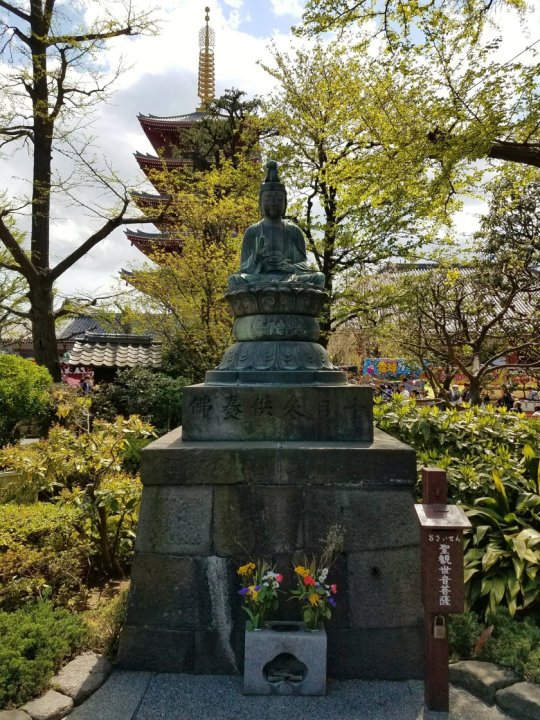

The Meiji Temple

The Main Gate

Nearby Street Market
We then hopped on the rail to Ueno and onto Ueno Onshi Park. We were on a mission to find cherry blossoms. I had heard that they had already bloomed, but there were some late bloomers around still. We were lucky to find some there!
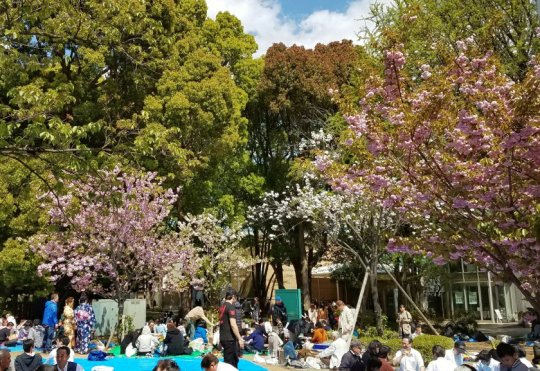
Having a Picnic Under the Sakura Trees
We also wanted to look for a cat café. According to the GPS, there was one nearby: Neko Maru Café Ueno (7 Chome Ueno, Taitō, Tokyo 110-0005, Japan). There was a fee schedule, but the one we chose was 30 minutes for $6 USD. They had coffee and tea, as well as some snacks. They also had a few bookcases so you could sit and read while surrounded by the cats. If you want, they also had kitty toys to engage with the cats/kittens in house.

Welcome to the Kitty Cafe!

Cafe Menu and Helper

There are Enough Boxes for Every Kitty!

Shh! Do Not Disturb!

This is Part of their Elevated Cat Walk

Pretty Fur-Baby!

Beautiful Bengal
Next stop: Akihabara to check out the electronics district.

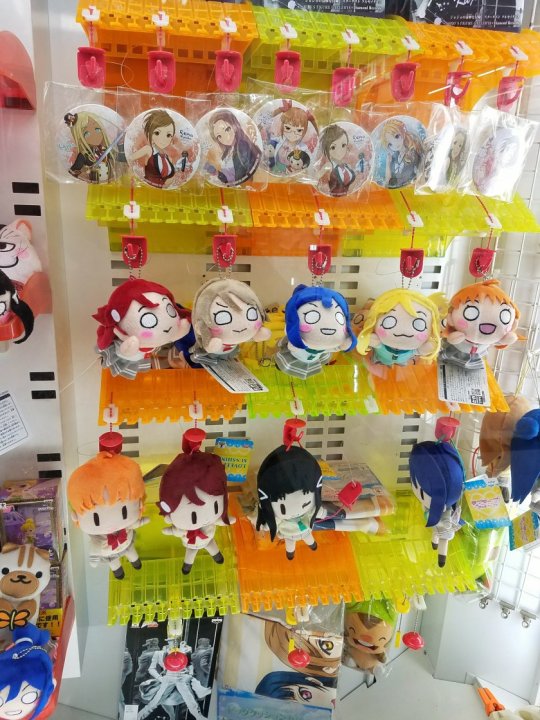
Inside the Sega Building – they have these types of games on the first 3 floors
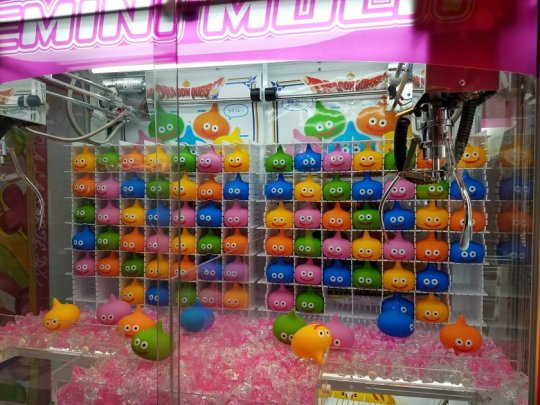
These Remind me of the Slime blog-things in Dragon Quest
The streets were closed for the shoppers.

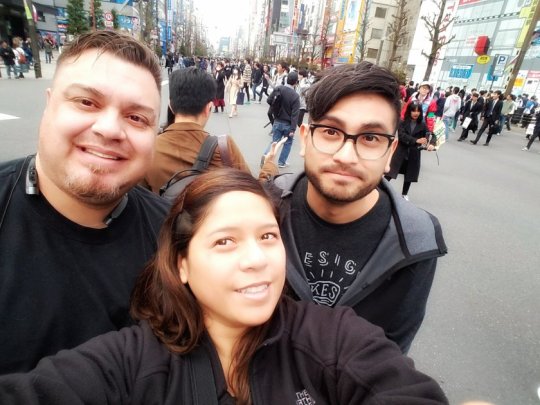
Proof of Life!

Interesting KitKat Variety
We noticed that some electronics were more expensive there than online. Only exception seemed to be those from Japan, and the prices seemed more fair.
After some shopping, we started back towards home for dinner and to sleep off some of the jetlag.

Salmon with Rice, Miso Soup, Pickles, Salt Cod Roe, and Egg
Monday, April 8, 2018: Mt Fuji
We went on a day tour through JAPANiCAN. Our first stop was the Mt Fuji 5th Station.
Unfortunately, we didn’t have as clear a view as we had hoped. It was also 1 degree below Centigrade when we were there, so just a little cold!

Mt. Fuji is Behind those Clouds Somewhere!
Next stop was at Oshino Hakkai. The snowmelt from Mt. Fuji formed several fresh water springs in the area. It’s also a cute little village where we were able to get another view of Mt. Fuji. The sun had come out and some of the clouds were starting to clear.

Mt. Fuji is starting to Peek Out thru the Cloud Cover!
There were some shops along the street – some selling food, others selling souvenirs.


These were very yummy BBQ Beef Skewers
Our next stop was Shiraito Falls. The falls are fed by the snowmelt from Mt. Fuji also. There were also a number of shops in the area, including soft serve ice cream.

Green Tea/Vanilla Mixed


Main Waterfall
Fujisan Hongu Sengen Taisha Shrine. The head shrine for Sengen and Asama shrines throughout Japan.


Shrine Entrance



The White Ties and Wooden Tags are All Wishes

Shrine’s Lagoon

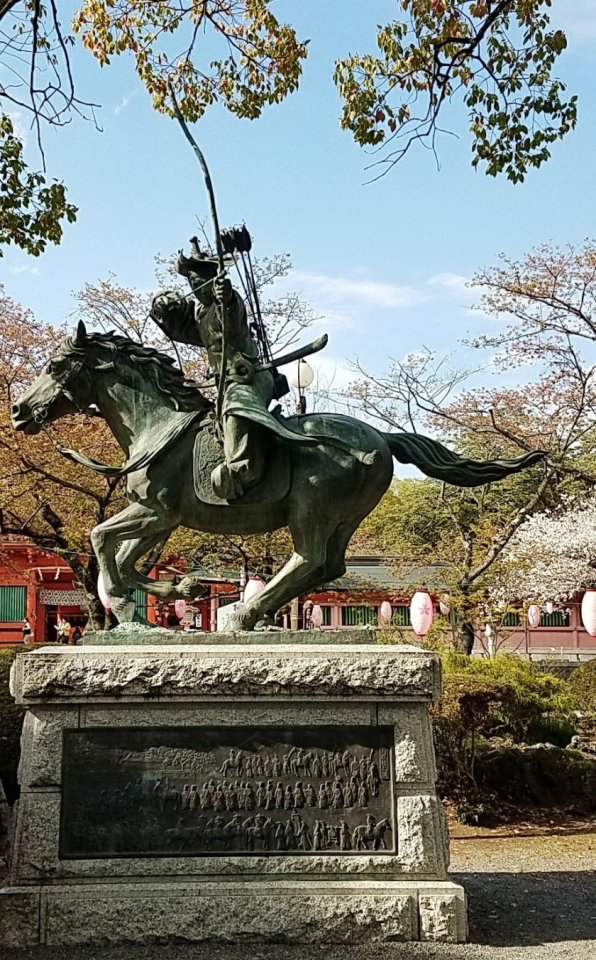

A Much Clearer View!
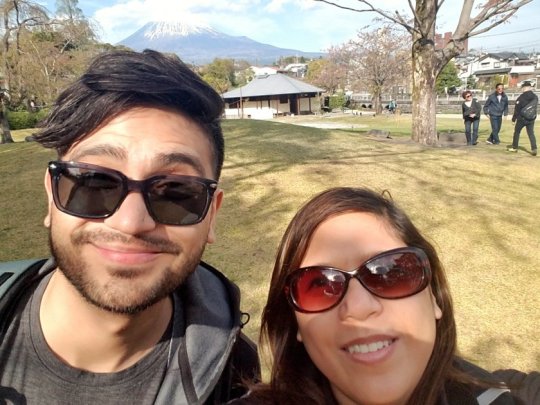
Happy With the Sight!
On our way back, our tour guide informed us that Mt. Fuji can be clearly seen 60 to 65 days out of the year (so we were lucky!)
For dinner, we stopped by one of the restaurants nearby our hotel – Akami Yakiniku Horumondokoro Nikuman. (1-23-6 Hamamatsucho, Minato 105-0013, Tokyo Prefecture).

We were seated at the bar. Each table/seat had a mini grill and a vent right above it. We decided to share the Tonya place.

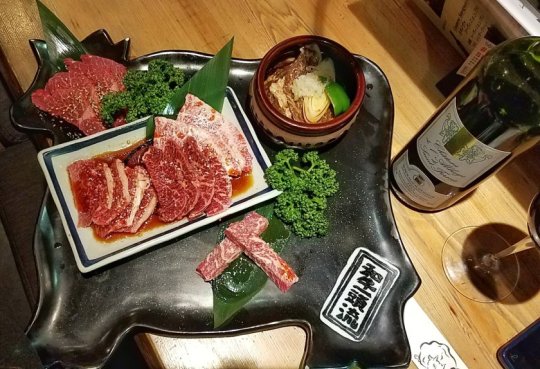
Since the meat is thinly sliced, it was cooked quickly.
With full stomachs after a full day, sleep came easy.
Tuesday, April 10, 2018: Tsukiji Fish Market, Namiyoke Inari Shrine, Hachiko Memorial Statue, Shibuya Crossing, Meiji Shrine, Ginza
Tsukiji Fish Market is a famous market located in Central Tokyo. It is the largest wholesale fish and seafood market in the world. As part of development for the upcoming Olympics in Tokyo 2020, the fish market is slated to be moved Toyosu, Kotu in the Fall of 2018. If you can get there anywhere from 3am to 5am, you can observe the tuna auction (we opted not to do that). If you do decide to go, it is highly recommended to wear rubber boots.
There is two parts of the market – the Inner Market, where wholesale vendors are located, and the Outer Market where people like us can purchase items in more manageable numbers.

Tea Vendor
We wanted to find one, if not two places to eat. So our first place was here (apologies, I’m not sure what it translates in English).

I felt like we were lucky because it wasn’t so crowded here, nor was there a line for us to wait in. As far as the food goes, I had once heard that “Fish should taste like the sea, and if it doesn’t, then it is no longer good.” The fish that we had here tasted exactly like the sea and I was extremely happy.

Traditionally Wasabi is In Between the Fish and the Rice (and they used FRESH Wasabi!)
After our sushi brunch, we continued walking through the market. Where a variety of items were up for sale as you can see here:



We came across another set of restaurants with long lines.


Apparently people lined up since opening to eat at these places.
After a few hours of walking and shopping, we decided to try another sushi place. This was located just outside the market, called Iwasa Sushi (6 Chome-27-3 Tsukiji, Chūō, Tokyo 104-0045, Japan). Incidentally it was highly rated on tripadvisor.com, so we wanted to see if it lived up to the hype. They have a set menu, and you basically choose between three or four different sets of sushi combinations. They only have seats at the sushi bar and they only accept cash.


Our Sushi Chefs

When we were done, I made a quick stop at Namiyoke Inari Shrine. Its name literally means “protection from waves.”

After that, we dropped off our purchases at the hotel and headed towards Shibuya.
Our first stop outside the Shibuya Station was the Hachiko Memorial. Hachiko was an Akita dog that was owned by Professor Ueno Hidesaburo from Tokyo Imperial University. Hachiko would meet Professor Ueno at Shibuya Station at the end of the day, and it became their routine. One day, Professor Ueno had a cerebral hemorrhage at the University, and never came home. However, Hachiko would go to the station every day for almost ten years. This statue is a symbol of the loyalty and love that Hachiko had for Ueno. Fun fact: Hachiko was present when the statue was unveiled.

There was a LONG line for taking pictures with the statue, so I improvised. The important thing was that I was there.

Now, there is a famous intersection near this statue that maybe the busiest intersection in the world: Shibuya Crossing. The lights turn red/green at the same time to control the pedestrian traffic. Even though there are crosswalks, when the light turns green, the intersection gets swarmed by people.
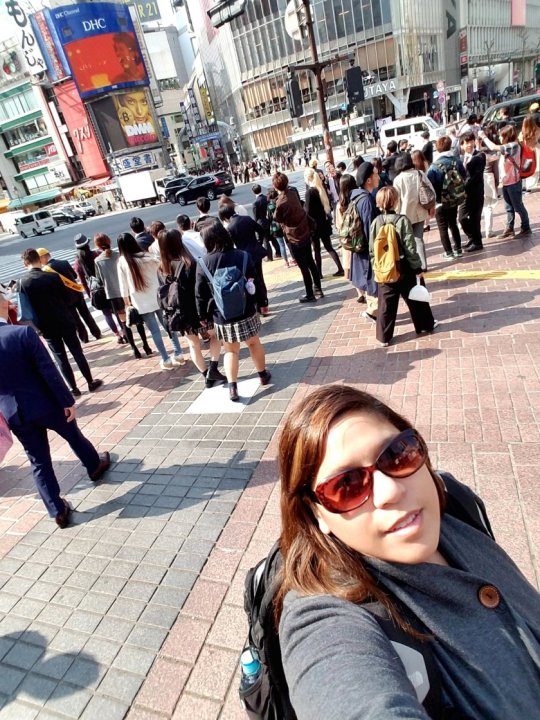
We crossed and survived (phew!)
We were walking through Shibuya in order to get to Meiji Shrine. In our walk, we encountered these:
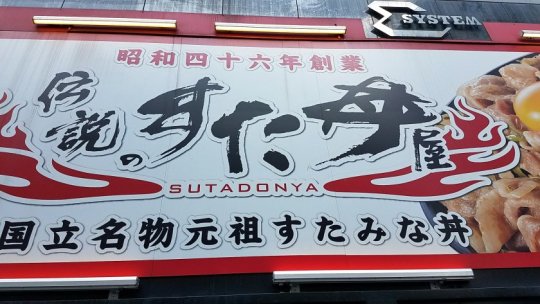
For Those Who are Familiar with Sutadonya at Mitsuwa in Arlington Hts…
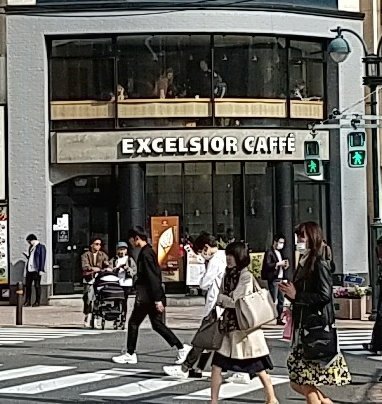
Stan Lee would Approve!
Meiji Shrine is a Shinto Shrine that is surrounded by a forest, and was built to honor Emperor Meiji and Empress Shoken.







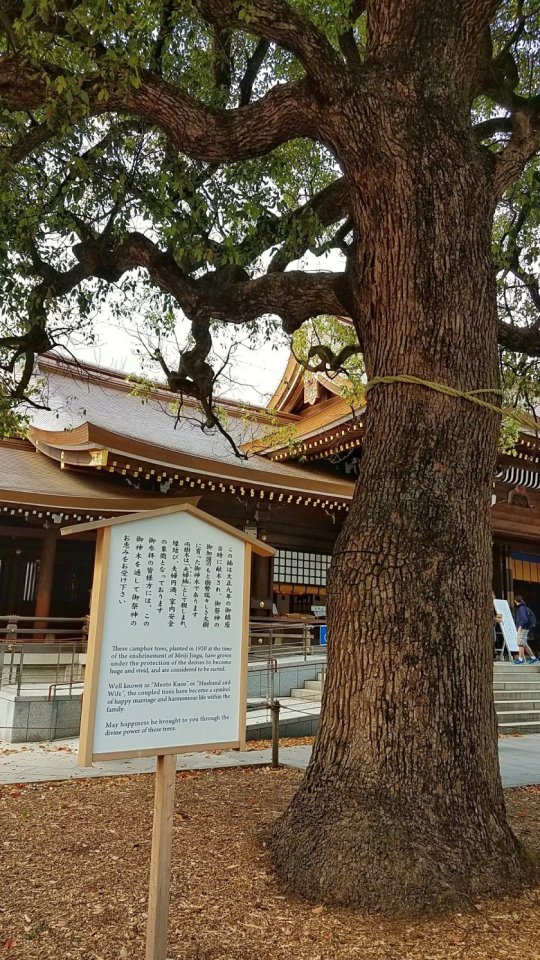
Camphor Tree

After that, we went back to our hotel to freshen up a bit before dinner: Itamae Sushi, Ginza Corridor (J Bld.1F, 8-2-13, Ginza, Chuo, Tokyo, 104-0061, Japan).
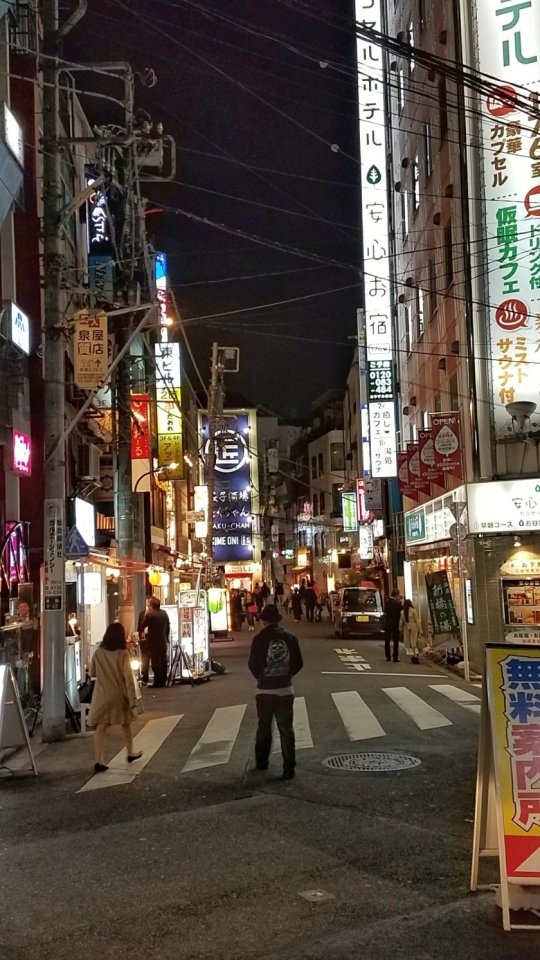
The City Never Sleeps!


Our Sushi Chefs at Ita Mae Sushi


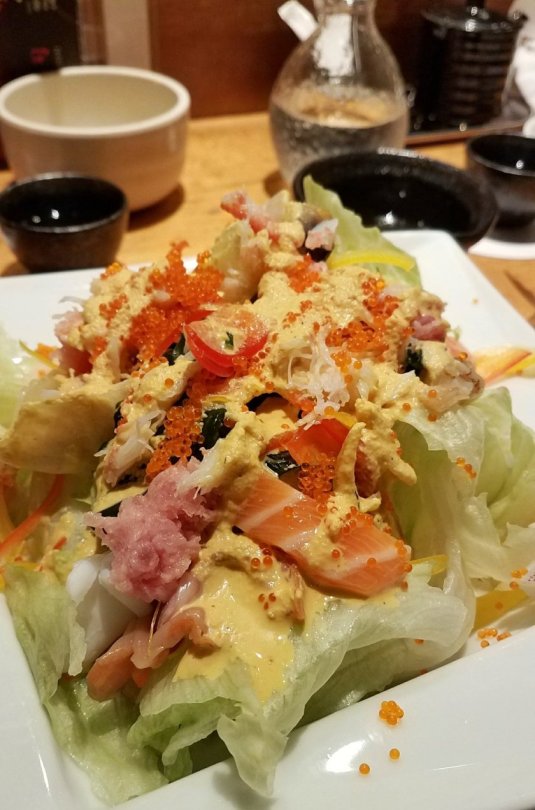
Fresh Seafood Salad

Sushi!

Menu Said “Live Squid” but I think they meant “Raw Squid” with Wasabi vinagrette (it was still good!)
So far, the only critique that I had was that they used powdered wasabi (what can I say, I was spoiled from the fresh wasabi from earlier today). However, the taste made up for it. I would have to say that the first place we ate at today and Itamae Sushi were the better of the three places we ate today.
Wednesday, April 11, 2018: Zojo-ji Shrine, Tokyo Tower, Departure
We had a half day left here in Tokyo. I decided to do a quick stop at Zojo-ji Shrine and Tokyo Tower before we left. There is also a mausoleum where the most loyal samurai are buried as well.


If Zojo-ji Shrine looks familiar, its because it was in the movie “Wolverine” (2013)


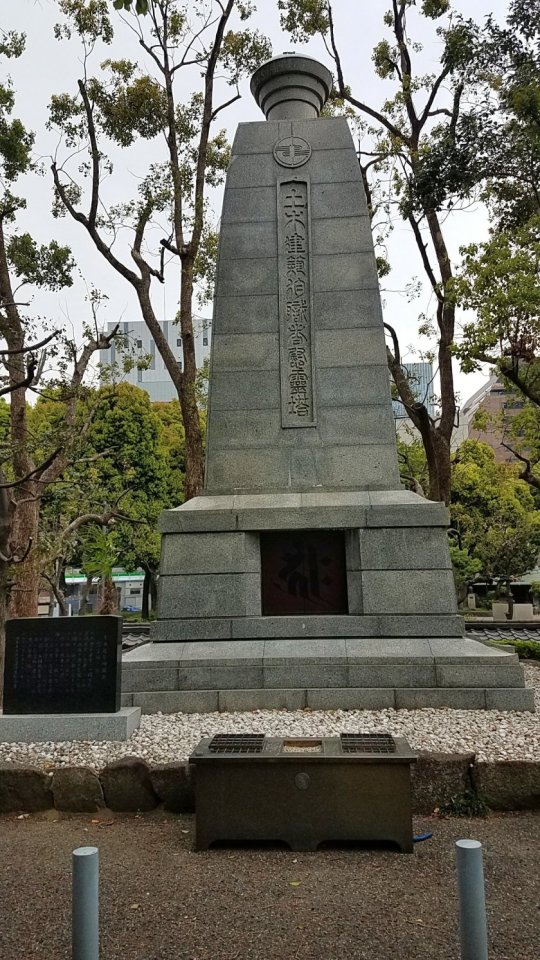


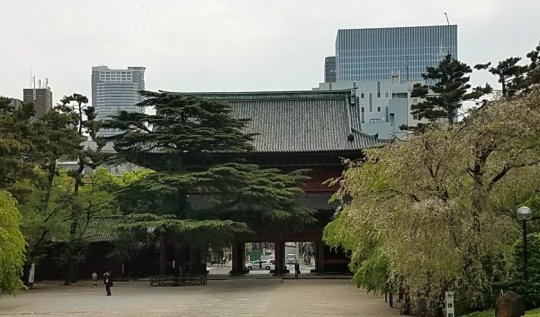

And Here I Have Come Full Circle!
In case you were wondering what I was doing at all those shrines, it was because of this: my notebook filled with Goshuin, which are unique stamps/seals and calligraphy from the temples that I had visited. I had been introduced to this during my first visit here and acquired quite a collection!
Alas, our trip had come to an end, but our hearts are full with the memories that we had made. Thank you for reading, and I hope that this inspired you for your next adventure!
–Maeven
Resources:
Mitsui Garden Hotel Shiodome Italia-gai. 2-14-24, Higashi-shimbashi, Minato-ku, Tokyo, 105-0021 https://www.gardenhotels.co.jp/shiodome-italiagai/eng/
Lawson Station (various locations). http://lawson.jp/en/
7-Eleven (various locations). http://www.sej.co.jp/in/en.html
Tokyo Station http://www.tokyoinfo.com/en/
Rokurinsha. https://www.yelp.com/biz/YD4NquiK0mPR_WMse5KPOA?utm_campaign=www_business_share_popup&utm_medium=copy_link&utm_source=(direct) http://www.rokurinsha.com/ (Japanese)
Neko Maru Café Ueno. http://www.nekomarucafe.com/index.html
1-Day World Heritage Mt. Fuji Tour. https://www.japanican.com/en/tour/detail/BUS1J00711MKS/?typecd=TOU&destcd=V21&kw=golden&sbit=4&typegrpcd=TPA
Akami Yakiniku Horumondokoro Nikuman. 1-23-6 Hamamatsucho, Minato 105-0013, Tokyo Prefecture. https://www.tripadvisor.com/Restaurant_Review-g1066451-d6047847-Reviews-Akami_Yakiniku_Horumondokoro_Nikuman-Minato_Tokyo_Tokyo_Prefecture_Kanto.html
The Tsukiji Fish Market. 5 Chome-2-1 Tsukiji, Chūō, Tokyo 104-0045, Japan. http://www.tsukiji-market.or.jp/tukiji_e.htm
Hachiko Memorial Statue. 1 Chome-2 Dogenzaka, Shibuya, Tokyo 150-0043, Japan.
Hachiko. https://en.wikipedia.org/wiki/Hachik%C5%8D
Meiji Shrine. 1-1 Yoyogikamizonocho, Shibuya, Tokyo 151-8557, Japan. http://www.meijijingu.or.jp/english/your/1.html
Itamae Sushi. J Bld.1F, 8-2-13, Ginza, Chuo, Tokyo, 104-0061, Japan. http://itamae.co.jp/english/
Zojo-ji. 4丁目-7-35 Shibakoen, Minato, Tokyo 105-0011, Japan. https://www.zojoji.or.jp/en/
Tokyo Tower. 4 Chome-2-8 Shibakoen, Minato, Tokyo 105-0011, Japan. https://www.tokyotower.co.jp/en.html
Wanderlust Wednesday: Trip to the Land of the Rising Sun Tokyo, Japan I am not sure why, but I had always been drawn to Japan. I originally went on a group tour around part of the country.
0 notes